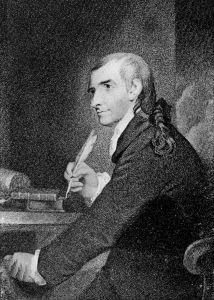Francis Hopkinson (September 21, 1737 – May 9, 1791) was a delegate from New Jersey during the Second Continental Congress and later served as a judge in Pennsylvania. He signed the Declaration of Independence after

New Jersey purged itself of its loyalist delegates in the First Continental Congress. He, along with John Witherspoon, Richard Stockton, John Hart, and Abraham Clark, voted in favor of independence from Great Britain. New Jersey would become one of the first middle colonies to vote for independence. Hopkinson also aided in the design of the American flag.
Francis Hopkinson's Early Career
Francis Hopkinson was not originally from the colony of New Jersey but was born in the province of Pennsylvania.
He received a good education and was admitted to the College of Philadelphia and became one of its first graduates (The College of Philadelphia is not the University of Pennsylvania). After graduating, he continued his academic career and received a master's degree. Shortly after graduation, he would begin a career in politics.
In 1761, the landscape of the 13 original colonies looked quite different than it did after the American Revolutionary War. The British and French were embattled in a war that Americans now call the French and Indian War.
Native Americans were hostile to colonists that lived on the frontier, and there were many raids. It was during this tumultuous time that Hopkinson served as the secretary to the Provincial Council of the Pennsylvania Indian Commission.
He would help author a treaty with the Delaware and Iroquois tribes that would calm the frontier of Pennsylvania for a time.
After successfully navigating this treaty, Hopkinson traveled to England, where he spent time with Lord North and pursued the position of commissioner of customs for North America. This did not come to pass, and Hopkinson was seen back in the colonies by 1768.
He would marry Ann Borden on September 1, 1768, and the two would have five children. During this time, he resided in Philadelphia, Pennsylvania, until he received a public appointment as a customs collector for New Castle, Delaware, and by 1774, he had moved to Bordentown, New Jersey, which he became an assemblyman for New Jersey's Royal Provincial Council. He resigned from this position in 1776 and took up the cause of an American patriot.
He was selected to replace the New Jersey delegation to the First Continental Congress at the Second Continental Congress. Here, he signed the Declaration of Independence.
American Revolutionary War
During the American Revolutionary War, Francis Hopkinson served on the Navy Board. He was treasurer of the Continental Loan Office in 1778. He served in many public offices throughout the war and was a strong supporter of George Washington.
After the war, he was appointed as a judge to the United States District Court for the District of Pennsylvania. This appointment was given to him by President George Washington.
Hopkinson served well but died suddenly from an epileptic seizure at the age of 53. He was buried in Christ Church Burial Ground in Philadelphia. His son, Joseph, would follow in his footsteps and become a United States Representative and a federal judge.
The Renaissance Man
Francis Hopkinson was a colonial renaissance man who not only engaged in politics but also had a love of the arts. During the American Revolutionary War, Hopkinson penned many poems, political satires, and pamphlets. Some of his most popular writings were:
- A Pretty Story (1774)
- The Prophecy (1776)
- The Political Catechism (1777)
Along with his writings, Hopkinson was a talented musician. He composed many songs throughout his life, including a collection of Psalms and Hymns for his local church congregation.
He also wrote eight songs that he dedicated to his good friend George Washington and his daughter.
